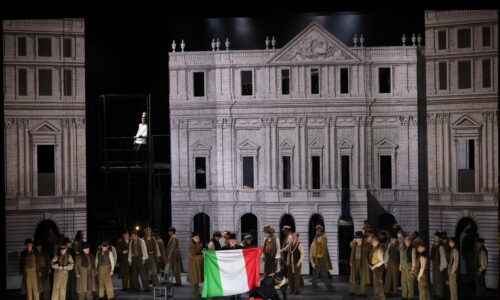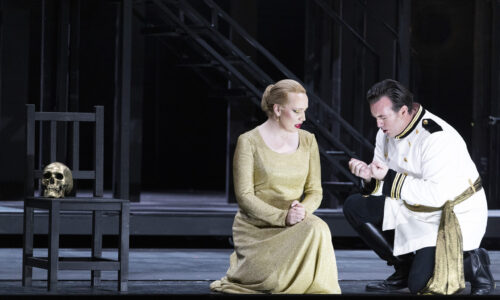NORMA
NORMA by Vincenzo Bellini. Tragedia lirica in two acts. Libretto by Felice Romani. Teatro alla Scala. Teatro alla Scala Orchestra and Chorus. New Production.
Far from the Moon
La Scala’s misrepresented Norma.
“May upon the Earth there be that peace
which through you reigns in heaven.”
Conductor FABIO LUISI
Pollione Freddie De Tommaso
Oroveso Michele Pertusi
Norma Marina Rebeka
Adalgisa Vasilisa Berzhanskaya
Clotilde Laura Lolita Perešivana
Flavio Paolo Antognetti
Staging OLIVIER PY
Sets and costumes PIERRE-ANDRÉ WEITZ
Lights BERTRAND KILLY
Choreography IVO BAUCHIERO
NORMA
All music lovers know that many, but truly many, famous theatrical pieces attracted various composers to write their own operatic versions. Almost always, it was the case of desiring to put one’s own musical stamp upon a literary work that moved society to such a degree that it virtually cried out for diverse interpretations. It was also shown that a successful drama would inspire artists of various ‘genre’ down through the ages to mold an archetype personage into a living character, thus choreographers, filmmakers, sculptors, photographers alike participated in a new movement. It is also true that few were ever destined to outdo the original. One wonders, too, why today’s stage directors so often put themselves into a corner in efforts to restructure, reinterpret or modernize artworks that have in themselves been so complete for hundreds of years.
Medea of Cherubini, 34 years before
The Druid priestess Norma remains such a figure. Around her swirl attributes making for high drama: a love triangle, a mythical setting from Classical antiquity wherein the individual and society are measured against each other, religious ethics call for great sacrifices, Man and his relation to Nature are juxtaposed, and the ideals of peace and war vie. Thus, the drama Norma, ou L’infanticide di Alexandre Soumet, premiering in Paris in April of 1831, was to inspire a libretto by Felice Romani, written in four months, and set to music by Bellini in three (!), to take the stage at Teatro La Scala on 26 December of that very same year. The time was ripe for an aesthetic blending of Classical with emerging Romantic tendencies. 1830-31 marked golden years for Felice Romani, who wrote almost all the libretti for Bellini’s operas – there appeared La Sonnambula, Norma, even Anna Bolena written for Donizetti. Romani had also touched upon themes close to the Norma myth with Medea in Corinto (1813), music by Johann Mayr and La Sacerdotessa d’Irminsul (1820), scored by Giovanni Pacini. So, you see how the opera Norma followed its destiny towards its own creation in quick succession; and yet, there was that Medea of Cherubini (1797), 34 years before. And now, here is Norma again at La Scala, last represented there about 50 years ago. Though all this is fascinating, this production’s social heritage and milieu have done no less than jink the ‘mise-en-scène’ of this current production.
Human fallibility and frailness
The causes of this delusion rest upon the shoulders of the stage director, Olivier Py. One should have known that Norma is a complex character and understood to be of a strong will, moving from one emotive action to another. The libretto is extremely well-crafted, and we can be initially deceived by her actions, only to discover her human fallibility and frailness; she is a victim, and ever-changing events condition her. Until, that is, she takes a moral stance, choosing to sacrifice herself for love and the benefit of society. Silver moonlight becomes that of a redeeming sun, being the fire of her funeral pyre, wherein order will then be restored. Why Py interferes with this, obtrusively integrating the myth of Medea into the stage action, is beyond comprehension.
Absurd choice
This ‘theater-within-a-theater’ structure was pre-announced by the stage director in his article for the La Scala program ‘Norma Revolutionary’, in which the personage Medea is mentioned seven times, almost as much as Norma, nine times. True, the theme of infanticide is a major theme linking the two operas, but it goes no further than that. Turning Medea into Norma’s ‘Doppelgänger’ for the entire opera was an absurd choice, and the principal reason for the fiasco. Py’s insisting the Norma should breathe the air of the Garibaldian Resurgence is forced, gratuitous, representing La Scala burning, and shown bombed during W.W. II was not justified, holding little emotion for the Italian audience. The sand-in-the-eye setting was brought to extremes when Py created a ‘pantomime’ for the almost 10 minutes of Bellini’s ‘Sinfonia’ and musical choral Introduction. We are in the square set before the fabled edifice. Invading Austrians are chasing Italian soldiers (Garibaldians), one of whom with a huge, unfurling Italian flag is caught, blindfolded and shot, then covered and carried away wrapped in the red, white, and green banner. All this to say that Norma will represent that struggle for independence, and scenes of war and its destruction will continue during the opera.
True failing of this staging
Yet, the true failing of this staging is the forced insertion of those danced-mimed scenes from Cherubini’s Medea, left in its classical ambiance, bathed in the blood sacrificing of Greek tragedy. It all refers to another storyline, and if one does not know Cherubini’s work, much is not understandable. It never balances as one imagines it was intended to, it never fits in with the action of Bellini’s opera. And when one does see a parallel, it is either useless or a distraction. Two platforms are rolled in various times as our Norma progresses; they are dressing rooms for Medea and Glauce. All is set in a Berlin of the 1920’s, an attempt to bring the action closer to our day perhaps. A topless male dancer writes the name ‘Medea’ on the mirror. The worst scene of all is when Norma enters to slay her sleeping children; they are on the floor of that dressing room, now depicting a sacrificial altar. As she sings, we are obliged to watch a dancer lift a mime, Medea onto the top in front of the mirror, menacing to kill the children. One wonders why the singers did not protest this continuous, irrelevant upstaging. Later, during a duet between Norma and Adalgisa, the two children donned paper hats, and on the opposite side of the stage, battled for seemingly hours with wooden play swords, jumping up and down noisily, tapping each other in ‘touché’ gestures. Were they here supposedly depicting tenderness and innocence, symbolizing their parents’ impossible love, so removed from the realities of the drama and thus left on their own to interact with the audience?
The scenery and costumes (Pierre-André Weitz), as too for the lighting (Bertrand Killy) reflected the director’s intentions. Two flats on the side represented the facade of La Scala, with a revolving stage in the center, which did, as happens with constant turning, become monotonous, while offering little surprise. The moon for the ‘Casta Diva’ scene was a round map, 1850-ish, lowed and hoisted by pulleys by a mime-dancer. The other scenic elements that came into view revealed a dead oak tree of the sacred forest at Irminsul, a golden staircase of neoclassic taste, whereon Norma makes her entrance, and must all-too-gingerly come down to the stage floor. There are lengthwise, artificial fireplace flames to give the idea of a sacrificial pyre funeral, yet Norma and Pollione are shot by a firing squad. The costumes are post-Victorian, 1890’s with top hats, and the ritual gowns of the priestesses almost bathrobes in essence. The lighting created its effects mostly by creating shadows as cast through the revolving metal structures. As to the overwhelming abundance of story-telling miming of the Medea myth as asked for by Py (choreography – Ivo Bauchiero), one can only recall dancers with small silver and golden skulls held in hand or deposited about the stage, perhaps leaving traces of that legendary ‘in illo tempore’ preceding recorded history.

For many, the music director Fabio Luisi was outstanding, perhaps most of all for the subtlety he conveyed in underscoring Bellini’s mannerisms and distinctiveness. Hardly ever were we allowed to let a dramatic moment or pure orchestral sound escape us. Those who feel they know Bellini’s musical characteristics were not let down. Think of the softness of adagio those flute passages that take the place of the usual oboe in expressing sadness, lament, and pensive isolation. And while it is true that Bellini’s melodic line captivated Verdi and Wagner, it is through the two great choruses of Norma that we sense the rousing emotions of both composers, especially so in Nabucco and Götterdämmerung – the great La Scala chorus sounded twice as voluminous. Also, the ‘tempi’ not only seemed right, but responded to the singer’s breathing; belcanto’ indeed, but something more. It was in the pacing of the great duets and trios wherein we sensed the music at the service of the drama; when the vocal line was soft and touching, the orchestra was even softer. In the hands of the right conductor, we understand why La Scala’s Orchestra and Chorus reach such great heights.
Norma and Adalgisa, Druid priestesses, carry the weight of much of the opera. Here, both capture the shared complexities that women in any society must domesticate, those double roles of survival within themselves. Marina Rebeka, a seasoned Norma, stood tall as the high priestess, red hair flaming (recalling Beverly Sills). Her first appearance preceding ‘Casta Diva’ is atop a steep staircase, and the slow walk downwards in a long gown almost touching the ground seems a throwback to many Turandot productions. The opera’s famed aria was handled admirably, both psychologically and vocally. Some may feel that the pressure here is not upon the challenges of the coloratura, but the changes of mood, extremely controlled, given that Norma is facing her people, deciding upon making war, or advocating peace, also protecting her doomed love affair with a proconsul of the invading Romans. Rekeka subtly rocked her populace to pacific sleep with her words beseeching the Goddess Moon of silver light to guide them through the wisdom that only Nature can provide: “… May upon the Earth there be that peace which through you reigns in heaven.” All through the opera, the great interpretative care afforded was deeply moving, and the constantly changing dramatic phrasing, whether alone, or with her lover, children, father or associate priestess was truly convincing. Add to that a rich vocal instrument that brought the beauty of Bellini’s music to us, and one knows that this performance is memorable.
Duets well-shaped in phrasing
No less moving was mezzo-soprano Vasilisa Berzhanskaya’s Adalgisa. She, too, just plainly sang beautifully, and grabbed onto all that is Italianate in Bellini; no easy feat. The timbre of her voice varied, inweaving through nuances of her complex situation, expressing the difficulties in hiding her love for Pollione from her best friend, only to regain her faithfulness in the end. The voice can grow as the drama enfolds, and we began to think of her opening night at La Scala in 2025 as Shostakovich’s Lady Macbeth of the Mtsensk District (Many of us prefer the alternative title, Katherina Ismailova.). Adalgisa’s duets with Norma were well-shaped in phrasing, sacrificing all to extract the emotions the drama demands. She expressed all the pathos of guilt mixed with joy in her aria “Sgombra è la sacra selva”.

As for the other singers, one senses that we obtained as much from them as we could. Tenor Freddie de Tommaso as the Roman proconsul Pollione acted and sang all too forcedly. The voice, while blossoming, seems to remain somewhat constricted. Overall, one senses that Bellini’s beauty of line was astray when passionate declaration was needed. The smaller roles of Oroveso, Norma’s father (Michele Pertusi), Clothilde, Norma’s nurse (Laura Lolita Perešivana) caring for her hidden children, and the centurion Flavio (Paolo Antognetti), a foil to Pollione’s plans were well-covered, but might have appeared somewhat more useful if interacting in the dimensions of another staging.
In a truly classical sense, as inspired by the antique values of society, the libretto and the music depict human and divine sacrifice. We have come to learn that imperfect Man will err, yet light will lead us out of darkness. Operatic destiny is always tragic, a victim of the illogical. In Norma, the characters uniquely show us ourselves at our worst, and it is simply the defeat of human nature with which we must grapple. We are harshly taught that we do not control our own lives, and we learn of the bitterness, hurt, and sadness that come from our actions. Perhaps it is true that what is humane in us is worth truly little; it is our emotions that all too often govern our actions.
